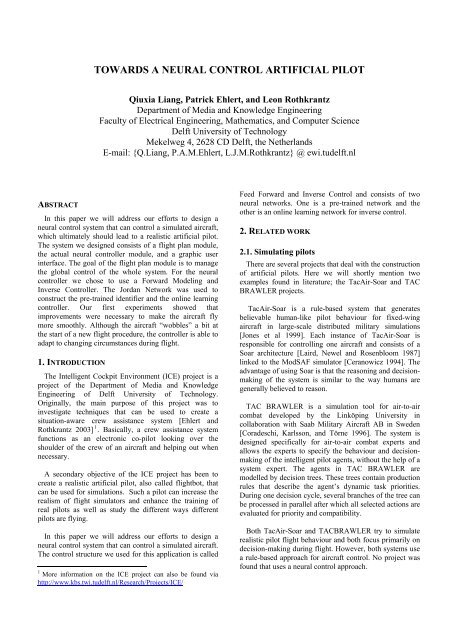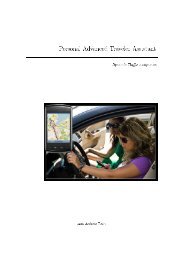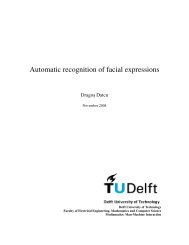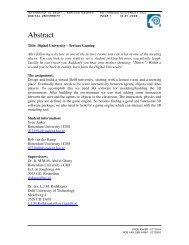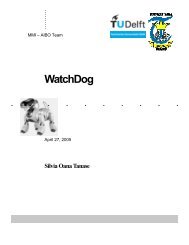Neural Flight Control Autopilot System - Knowledge Based Systems ...
Neural Flight Control Autopilot System - Knowledge Based Systems ...
Neural Flight Control Autopilot System - Knowledge Based Systems ...
You also want an ePaper? Increase the reach of your titles
YUMPU automatically turns print PDFs into web optimized ePapers that Google loves.
TOWARDS A NEURAL CONTROL ARTIFICIAL PILOT<br />
Qiuxia Liang, Patrick Ehlert, and Leon Rothkrantz<br />
Department of Media and <strong>Knowledge</strong> Engineering<br />
Faculty of Electrical Engineering, Mathematics, and Computer Science<br />
Delft University of Technology<br />
Mekelweg 4, 2628 CD Delft, the Netherlands<br />
E-mail: {Q.Liang, P.A.M.Ehlert, L.J.M.Rothkrantz} @ ewi.tudelft.nl<br />
ABSTRACT<br />
In this paper we will address our efforts to design a<br />
neural control system that can control a simulated aircraft,<br />
which ultimately should lead to a realistic artificial pilot.<br />
The system we designed consists of a flight plan module,<br />
the actual neural controller module, and a graphic user<br />
interface. The goal of the flight plan module is to manage<br />
the global control of the whole system. For the neural<br />
controller we chose to use a Forward Modeling and<br />
Inverse <strong>Control</strong>ler. The Jordan Network was used to<br />
construct the pre-trained identifier and the online learning<br />
controller. Our first experiments showed that<br />
improvements were necessary to make the aircraft fly<br />
more smoothly. Although the aircraft “wobbles” a bit at<br />
the start of a new flight procedure, the controller is able to<br />
adapt to changing circumstances during flight.<br />
1. INTRODUCTION<br />
The Intelligent Cockpit Environment (ICE) project is a<br />
project of the Department of Media and <strong>Knowledge</strong><br />
Engineering of Delft University of Technology.<br />
Originally, the main purpose of this project was to<br />
investigate techniques that can be used to create a<br />
situation-aware crew assistance system [Ehlert and<br />
Rothkrantz 2003] 1 . Basically, a crew assistance system<br />
functions as an electronic co-pilot looking over the<br />
shoulder of the crew of an aircraft and helping out when<br />
necessary.<br />
A secondary objective of the ICE project has been to<br />
create a realistic artificial pilot, also called flightbot, that<br />
can be used for simulations. Such a pilot can increase the<br />
realism of flight simulators and enhance the training of<br />
real pilots as well as study the different ways different<br />
pilots are flying.<br />
In this paper we will address our efforts to design a<br />
neural control system that can control a simulated aircraft.<br />
The control structure we used for this application is called<br />
1 More information on the ICE project can also be found via<br />
http://www.kbs.twi.tudelft.nl/Research/Projects/ICE/<br />
Feed Forward and Inverse <strong>Control</strong> and consists of two<br />
neural networks. One is a pre-trained network and the<br />
other is an online learning network for inverse control.<br />
2. RELATED WORK<br />
2.1. Simulating pilots<br />
There are several projects that deal with the construction<br />
of artificial pilots. Here we will shortly mention two<br />
examples found in literature; the TacAir-Soar and TAC<br />
BRAWLER projects.<br />
TacAir-Soar is a rule-based system that generates<br />
believable human-like pilot behaviour for fixed-wing<br />
aircraft in large-scale distributed military simulations<br />
[Jones et al 1999]. Each instance of TacAir-Soar is<br />
responsible for controlling one aircraft and consists of a<br />
Soar architecture [Laird, Newel and Rosenbloom 1987]<br />
linked to the ModSAF simulator [Ceranowicz 1994]. The<br />
advantage of using Soar is that the reasoning and decisionmaking<br />
of the system is similar to the way humans are<br />
generally believed to reason.<br />
TAC BRAWLER is a simulation tool for air-to-air<br />
combat developed by the Linköping University in<br />
collaboration with Saab Military Aircraft AB in Sweden<br />
[Coradeschi, Karlsson, and Törne 1996]. The system is<br />
designed specifically for air-to-air combat experts and<br />
allows the experts to specify the behaviour and decisionmaking<br />
of the intelligent pilot agents, without the help of a<br />
system expert. The agents in TAC BRAWLER are<br />
modelled by decision trees. These trees contain production<br />
rules that describe the agent’s dynamic task priorities.<br />
During one decision cycle, several branches of the tree can<br />
be processed in parallel after which all selected actions are<br />
evaluated for priority and compatibility.<br />
Both TacAir-Soar and TACBRAWLER try to simulate<br />
realistic pilot flight behaviour and both focus primarily on<br />
decision-making during flight. However, both systems use<br />
a rule-based approach for aircraft control. No project was<br />
found that uses a neural control approach.
The possible advantage of neural control over a rulebased<br />
approach is that there is no need to specify rules for<br />
pilot behaviour. Although rule-based approaches are very<br />
suitable to model normative pilot behaviour, it is much<br />
more difficult to model the different styles that different<br />
pilots use for flying. Secondly, using neural networks<br />
automated learning can be used to avoid the difficult<br />
process of explicating flight rules and finetuning rules and<br />
parameters. Thirdly, neural networks allow automatic<br />
adjustment to changing circumstances, such as different<br />
weather conditions, different aircraft, and malfunctioning<br />
controls.<br />
2.2. <strong>Neural</strong> networks and flight control<br />
The first <strong>Neural</strong> Network (NN) controller was<br />
developed by Widrow and Smith in 1963. Since then<br />
many applications have shown that NNs can be applied<br />
successfully to control unknown nonlinear systems. There<br />
have been a number of studies that investigated neural<br />
networks for flight control, for example [Calise<br />
1996],[Wyeth et al 2000],[Pesonen et al 2004]. However,<br />
all neural control studies try to improve (a particular part<br />
of) automated flight control and focus mainly on the<br />
control of Unmanned Aerial Vehicles (UAVs), helicopters,<br />
and missiles. Their goal is simply to create a controller that<br />
functions as good as possible. We did not find any studies<br />
that investigated neural networks for simulating realistic<br />
flight behaviour of real pilots.<br />
3. SYSTEM DESIGN<br />
3.1. General system scheme<br />
The essential element of a powerful and flexible neural<br />
control system is of course the controller itself. However,<br />
to create a flightbot we also need some assistant parts, for<br />
example a flight-planning system.<br />
Our system has been divided into three parts according<br />
to the different tasks and functions which are; the graphic<br />
user interface, the flight plan module, and the neural<br />
controller module. Figure 1 shows the general system<br />
scheme. The user interface sends orders from the user to<br />
the flight plan system. The flight plan system will analyse<br />
the order to determine whether it is reasonable or not. If it<br />
is reasonable, the planning system will create a flight plan,<br />
which consists of at least one flight procedure. Then, the<br />
planning system will send different data (the desired plant<br />
output) to the controller module corresponding to each<br />
flight procedure. The controller will produce the necessary<br />
control data that will finally be applied to the plant<br />
(aircraft).<br />
Figure 1: general scheme of the neural flight control autopilot<br />
system<br />
3.2. <strong>Flight</strong> plan module<br />
The goal of the flight plan module is to manage the<br />
global control of the whole system. The flight plan module<br />
will keep an eye on the flight process and update its flight<br />
records to provide the proper plant output data. To be<br />
precise the duties of the flight plan module are:<br />
• Analyzing the reasonability of the current goal;<br />
• Deciding on the flight plan;<br />
• Providing the controller with the necessary data<br />
corresponding to each part of the flight plan;<br />
• Checking the current flight situation.<br />
Figure 2 shows a scheme of the flight plan system<br />
module.<br />
Figure 2: the flight plan system model<br />
The flight plan module choses one of more procedures<br />
based on the goal that is currently set by the user as well as<br />
on the state of the aircraft and the environment. Figure 3<br />
shows the (simplified) relationship between the goal of the<br />
flight plan module and the chosen flight procedures. With<br />
“default flying” we mean straight and level flight.
Figure 3: flight strategies<br />
3.3. <strong>Neural</strong> control module<br />
For the neural control module we have looked into<br />
several neural network control topologies. For our<br />
purposes we investigated three often-used neural network<br />
control topologies:. Direct Inverse <strong>Control</strong>, <strong>Neural</strong><br />
Predictive <strong>Control</strong> and Forward Modeling and Inverse<br />
<strong>Control</strong>.<br />
Topology comparisons<br />
In the Direct Inverse <strong>Control</strong>ler the structure will force<br />
the network to represent the inverse of the plant. However,<br />
there are drawbacks to this approach. First, if the nonlinear<br />
system mapping is not one-to-one then an incorrect inverse<br />
can be obtained. Second, inverse plant models are often<br />
instable, which may lead to the instability of the whole<br />
control-system.<br />
The <strong>Neural</strong> Predictive <strong>Control</strong>ler consists of four<br />
components, a plant to be controlled, a reference model<br />
that specifies the desired performance of the plant, a neural<br />
network modelling the plant, and an optimisation model<br />
used to produce the plant input vector. The object is to<br />
have an input vector for which the value of the cost<br />
function is lower than a defined value. Then the first<br />
element of the plant input for current time will be applied<br />
to the plant. The Newton-Rhapson algorithm has been<br />
widely used for the optimisation model to determine the<br />
best-input vector. The main disadvantages of <strong>Neural</strong><br />
Predictive <strong>Control</strong> are that numerical minimization<br />
algorithms are usually very time consuming (especially if a<br />
minimum of a multivariable function has to be found),<br />
what may make them unsuitable for real-time applications.<br />
When sampling intervals are small, there may be no time<br />
to perform minimum searching between sampling.<br />
Additionally, the prediction controller requires an<br />
accurately trained neural network model to simulate the<br />
plant, since the result of the whole controller system<br />
depends on the correct prediction value.<br />
The Forward Modeling and Inverse <strong>Control</strong> (see Figure<br />
4) has an additional NN plant model, compared to the<br />
Direct Inverse <strong>Control</strong>, which is used in the inverse neural<br />
network training process. The error signal is propagated<br />
back through the forward model and to the inverse model.<br />
However, only the inverse network model is adapted<br />
during this procedure.<br />
Figure 4: basic Forward Modeling and Inverse <strong>Control</strong><br />
The error signal for the training algorithm in this case is<br />
the difference between the training signal and the system<br />
output (it may also be the difference between the training<br />
signal and the forward model output in the case of noisy<br />
systems, which is adopted when the real system is not<br />
viable). Jordan and Rumelhart [1992] have showed that<br />
using the real system output it can produce an exact<br />
inverse controller even when the forward model is inexact,<br />
which will not happen when the forward model output is<br />
used. Another plus is that since the controller neural<br />
network gets trained assuming the correct plant input is<br />
equal to the backpropagated error from the forward model<br />
plus controller output, the training process will be stable.<br />
All things considered, we have chosen the Forward<br />
Modeling and Inverse <strong>Control</strong>, mainly because we want<br />
our pilot controller to run in real-time alongside flight<br />
simulator software, so we do not have much CPU time<br />
available. In addition, as mentioned above Forward<br />
Modeling and Inverse <strong>Control</strong> is better in producing an<br />
inverse controller.<br />
Airplane system modeling<br />
Figure 5 shows the representation of the basic airplane<br />
model used for our application, which has four inputs<br />
(elevator, throttle, rudder and aileron control) and four<br />
outputs (airspeed, pitch, heading and bank).<br />
Figure 5: the basic airplane model<br />
The elevator and throttle directly influence the airspeed<br />
and pitch of an aircraft, whereas the rudder and aileron<br />
directly influence heading and bank. The ailerons control<br />
is used to bank the airplane in the direction the pilot wants<br />
to turn, and the rudder control is used to keep the nose of<br />
the airplane pointing to the direction of turn.<br />
If we only look at the relation between elevator/throttle<br />
and airspeed/pitch, we can represent this dynamical system<br />
as in Figure 6, which is used for the input and output<br />
analysis.
For simplicity reasons, in our first implementation we<br />
only looked at elevator/throttle and airspeed/pitch. We did<br />
not implement turning.<br />
Figure 6: input-output relationship for the elevator/throttle and<br />
airspeed/pitch model<br />
This interconnected dynamic system has (d 1 , d 2 ) as input<br />
and (y 1 , y 2 ) as output, in which d 1 denotes the elevator<br />
input, d 2 denotes the throttle input, y 1 denotes the pitch<br />
output and y 2 denotes the airspeed output. In the dynamic<br />
sub-system Σ 1, the input d 1 + y 2 produces the output y 1 ,<br />
which means the current elevator input and current<br />
airspeed value determine the pitch value of the next cycle.<br />
In the dynamic sub-system Σ 2 , the input d 2 + y 1 produces<br />
the output y 2 , which means the current throttle input and<br />
current pitch value determine the airspeed value of the<br />
next cycle.<br />
Besides airspeed and pitch, there are also some other<br />
parameters influenced by the throttle and the elevator<br />
controls, like altitude and vertical speed. Compared with<br />
airspeed and pitch, those parameters are the indirect results<br />
of the throttle and the elevator controls. For example, if the<br />
airplane is in the air and pitches up, then the altitude will<br />
increase and the vertical speed will be a positive value.<br />
Therefore, we regard the altitude value and the vertical<br />
speed value as the references, instead of the parameters<br />
that should be used in the system modelling. For example,<br />
when the user sets a flight order for the airplane, besides<br />
the flight action he (she) will also be asked to set the<br />
altitude the airplane should fly to and this value is checked<br />
by the system during flight to analyse the situation.<br />
For more details on how throttle and elevator influences<br />
airspeed and pitch, or on flying the Cessna aircraft in<br />
general, the interested reader is referred to the Microsoft<br />
<strong>Flight</strong> Simulator manual [2002].<br />
4. IMPLEMENTATION<br />
All software was written using Visual C++ 6.0<br />
environment and in C language. For each module we<br />
tested the functions seperatly before I we did a full<br />
system’s test. The neural networks were implemented<br />
using a program that is called the Stuttgart <strong>Neural</strong><br />
Network Simulator (SNNS). SNNS is an open source<br />
program, which not only provides the interface to<br />
construct the neural network and simulate its running, it<br />
also offers a variety of kernel functions for the creation<br />
and manipulation of networks that can be combined in the<br />
user’s own program [Zell et al 1995]. The simulator we<br />
used to test our controller is the Microsoft <strong>Flight</strong> Simulator<br />
2000. The default Cessna 172 aircraft was chosen for all<br />
experiments described in this paper.<br />
We first trained a neural network to model the airplane<br />
plant using SNNS. The topology we used to construct the<br />
identifier is the Jordan Network. From experiments we<br />
found that, due to its simplicity, the Jordan Network (see<br />
Figure 7) is better for on-line training than the other<br />
network we tried, a Non-linear AutoRegressive Moving<br />
Average (NARMA) network (see also [Liang 2004] for<br />
more details).<br />
Figure 7: topology of the Jordan Network and the structure of its<br />
context PE<br />
The difference between a common neural network and a<br />
recurrent neural network, such as the Jordan Network, is<br />
that in a recurrent neural network there is a context<br />
Processing Element (PE). In the right part of Figure 7 you<br />
can see, the one-step delay in the context PE. After this<br />
one-step delay, the output of the neuron is returned as an<br />
input. For the Jordan network, the context PEs only exists<br />
in the input layer, and there is no recurrency in the inputoutput<br />
path.<br />
<strong>Based</strong> on early experiments, we came to the conclusion<br />
that for an identifier whose input-output relationship is not<br />
so complex, one hidden layer with around 20 neurons is<br />
enough. Of course, one can construct a multi hidden layer<br />
neural network with each hidden layer having around 12<br />
neurons. However, it will not improve results much and<br />
only waste time in training. Therefore, in our application<br />
we used only one hidden layer.<br />
After training the identifier was fixed. The controller<br />
was also constructed using the Jordan Network and trained<br />
in real-time.<br />
5. TESTING<br />
During the implementation phase of each module, we<br />
already tested each function separately. When the<br />
implementation was finished we performed a full system’s<br />
test. During the full system’s test we encountered several<br />
problems in the current control system:<br />
• The airplane wobbled a lot at the start of each flight<br />
procedure (visible in Figure 8);<br />
• The airplane kept descending during the default<br />
flying procedure (see the lower picture in Figure 9);
• The airplane changed its behaviour dramatically<br />
when going from one flight procedure to another<br />
(see the upper picture in Figure 9);<br />
comparison, you may see the pitching magnitude has<br />
decreased considerably.<br />
Figure 8: pitch error during the taxiing and flying up procedure<br />
Figure 10: pitch error comparison between original (left) and<br />
improved controller (right)<br />
From the pitch signal, which is the lower plot in Figure<br />
11, you can see that at the start of the default flying<br />
procedure, the pitch is levelling off gradually, resulting in<br />
a slow increase of the altitude until it settles on a certain<br />
value. Compared to the altitude plot in Figure 9, it is clear<br />
that the improved reference model of the desired plant<br />
output makes the airplane fly much better.<br />
Taxiing Flying Up Default Flying<br />
Figure 11: altitude (top) and pitch error (bottom) during the takeoff<br />
and fly to 2000 feet procedures<br />
Figure 9: pitch error (top) and altitude (bottom) during take-off<br />
6. IMPROVEMENTS AND EVALUATION<br />
Trying to solve the above-mentioned problems, we came<br />
to the following solutions;<br />
• Limit the controller’s output range of the elevator;<br />
• Change the desired pitch value for the default flying<br />
procedure, slightly above 0;<br />
• Modify the reference table used by the controller to<br />
make the desired pitch output change gradually.<br />
6.1. Results<br />
Figure 10 shows the pitch error during the taxiing and<br />
the flying up procedure. The pitch error shown in the right<br />
plot is taken from the airplane controlled by the improved<br />
controller and the data shown in the left plot is from the<br />
airplane controlled by the previous controller. From the<br />
Figure 12: altitude (top) and pitch error (bottom) during take-off,<br />
flying up and flying down procedures
Figure 12 shows the altitude and pitch error during a<br />
flight were the aircraft flew up to 2000 feet, then up to<br />
4000 feet, and again down to 2500 feet. The red line in the<br />
lower part of Figure 12 shows the actual pitch output value<br />
while the blue line is used to visualize the desired pitch<br />
output value. From the comparison we can see that the<br />
neural controller can respond to changes of the desired<br />
pitch value immediately. In another words, the controller<br />
has fast reaction ability.<br />
6.2. <strong>Control</strong>ler stability analysis<br />
There are several ways to analyse the stability of the<br />
controller. For example, we may characterize stability<br />
from an input-output viewpoint, or we can characterize<br />
stability by studying the asymptotic behaviour of the state<br />
of the system near steady-state solutions, like equilibrium<br />
points. We prefer to use the steady-state stability analysis,<br />
so we studied if the current system is asymptotic stable<br />
and characterized the attraction region.<br />
• <strong>Control</strong> the airplane to take off, fly up and fly down;<br />
• Run alongside the Microsoft <strong>Flight</strong> Simulator,<br />
which is a large CPU time consuming application;<br />
• <strong>Control</strong> the airplane so that it achieves a stable<br />
flight;<br />
• Respond to the changes of the desired plant output<br />
immediately;<br />
• Provide the current flight situation to the user and<br />
visualize the evaluation data in 2D coordinates in<br />
real time.<br />
The test results also show that the training of the<br />
controller neural network is affected by the pre-defined<br />
desired plant output. Therefore, setting the proper desired<br />
plant output for each flight procedure is very crucial for a<br />
good controller system.<br />
As mentioned before, one of our improvements was to<br />
limit the output range of the elevator control to decrease<br />
the “wobbling” pitching magnitude, but this phenomenon<br />
still occurs (to a much smaller extent) at the beginning of<br />
each flight procedure. It does disappear as training<br />
progresses, as can be seen in Figure 15.<br />
Figure 13: elevator (left) and throttle input (right) during the<br />
flying up procedure<br />
Figure 15: normalized elevator input (left) and pitch value (right)<br />
during flying up procedure<br />
Figure 14: pitch (left) and the airspeed output (right)<br />
corresponding to Figure 13<br />
Figure 13 shows that at the start of the control phase<br />
both the elevator input and the throttle input start with an<br />
arbitrary value. As the process goes on, both slowly settle<br />
on a certain value to achieve the desired pitch and airspeed<br />
output. Figure 14 includes the corresponding pitch value<br />
and the airspeed value taken from the elevator control<br />
input and the throttle control input.<br />
With a smaller input the output will be smaller also, and<br />
the control inputs will finally settle on a certain value to<br />
achieve a certain desired output. These two characteristics<br />
indicate that this control system is asymptotic stable.<br />
7. CONCLUSIONS AND DISCUSSION<br />
7.1. Conclusions<br />
The results presented in the previous chapter<br />
demonstrate that the current neural flight controller system<br />
can:<br />
Figure 16: altitude corresponding to Figure 15<br />
7.2. Discussion<br />
Unfortunately, the “wobbling” pitch phenomena cannot<br />
be avoided if we stick to the continuous online training of<br />
the single neural controller system that we use. However,<br />
we feel that this is not a big problem, since this<br />
phenomenon can also be found in normal piloting<br />
behaviour, which we ultimately intend to simulate.<br />
Figure 16 shows that the overall change in altitude<br />
progresses as normal and small variations are only visible<br />
on closer inspection.
Because of its online training ability, the developped<br />
neural controller system can adapt itself to new situations<br />
as they arise. This makes our neural network controller<br />
more flexible than rule-based control technique, like fuzzy<br />
control. With fuzzy control one would define the control<br />
rules beforehand, based on the experience of the expert.<br />
The advantage of fuzzy control is that for some problems<br />
one may have an intuitive idea about how to achieve high<br />
performance control, but the consequent problem is that a<br />
human expert cannot predict all situations that can occur.<br />
Even if the expert is able to predict everything and write it<br />
into rules, the rule base will become large and complex,<br />
and might not balance the stability criteria and the<br />
performance objectives.<br />
Our neural flight control system is flexible and can be<br />
applied to different aircraft applications. The architecture<br />
will remain the same. Adapting to other aircraft only<br />
requires replacing the pre-trained neural network identifier<br />
by another suitable one and indicating the desired output<br />
of the airplane.<br />
8. FUTURE WORK<br />
As discussed in the last section, the neural control<br />
system will make the airplane fly not smoothly at the start<br />
of a flying procedure. Although it is not very troublesome<br />
we would like to be able to simulate pilots that do not try<br />
to correct the pitch. One possible solution we are thinking<br />
of is the following. The current neural network controller<br />
is trained at each time there is a training pattern available,<br />
which will make the controller quite “sensitive”. Instead of<br />
training the controller every time a training pattern is<br />
available, we could train it when, for example, 10 training<br />
patterns are available. Then the airplane could keep the<br />
current pitch for a while.<br />
Of course our current neural control autopilot system is<br />
still quite limited. It can only control the airplane to fly up<br />
and down in a straight line. For future’s work, we plan to<br />
incorporate more functions such as turning and landing.<br />
Coradeschi, S., Karlsson, L. and Törne, A. (1996) “Intelligent<br />
agents for aircraft combat simulation”, in Proceedings of the<br />
6 th Computer Generated Forces and Behavioral<br />
Representation Conference, pp. 23-25, July 1996, Orlando,<br />
Florida, US.<br />
Ehlert, P.A.M. and Rothkrantz, L.J.M. (2003) “The Intelligent<br />
Cockpit Environment Project”, Research Report DKS03-<br />
04/ICE 04, <strong>Knowledge</strong> <strong>Based</strong> <strong>System</strong>s Group, Delft<br />
University of Technology, The Netherlands.<br />
Jones, R.M., Laird, J.E., Nielsen, P.E., Coulter, K.J., Kenny, P.<br />
and Koss, F.V. (1999) “Automated intelligent pilots for<br />
combat flight simulation”, in AI Magazine, Vol. 30, No.1, pp.<br />
27-41<br />
Jordan, M.I. and Rumelhart, D.E. (1992) “Forward models:<br />
Supervised learning with a distal teacher”, in Cognitive<br />
Science, Vol. 16, No.3, pp. 307-354<br />
Microsoft (2002) “Rod Machado’s Ground School”, Microsoft<br />
<strong>Flight</strong> Simulator 2002 manual.<br />
Laird, J.E., Newell, A. and Rosenbloom, P.S. (1987) “Soar: and<br />
architecture for general intelligence”, in Artificial<br />
Intelligence, Vol. 33, No.1 pp.1-64<br />
Liang, Q, (2004) “<strong>Neural</strong> flight control autopilot system”, MSc<br />
thesis, Research Report DKS04-04 / ICE 09, Delft University<br />
of Technology, The Netherlands.<br />
Pesonen, U.J., Steck, J.E. and Rokhsaz, K. (2004) “Adaptive<br />
neural network inverse controller for general aviation<br />
safety”, in AIAA Journal of Guidance, <strong>Control</strong>, and<br />
Dynamics, Vol.27, No.3 (May–June), pp. 434-443<br />
Wyeth G.F., Buskey G. and Roberts J. (2000) “<strong>Flight</strong> control<br />
using an artificial neural network”, in Proceedings of the<br />
Australian Conference on Robotics and Automation (ACRA<br />
2000), August 30 - September 1, Melbourne, pp. 65 -70.<br />
Zell, A., Mamier, G., Vogt, M., Mach, N., Huebner, R.,<br />
Herrmann, K.U., Soyez, T., Schmalzl, M., Sommer, T.,<br />
Hatzigeogiou, A., Doering, S., Posselt, D (1995) “SNNS<br />
Stuttgart <strong>Neural</strong> Network Simulator”, User Manual, version<br />
4.1, Report No. 6/95, University of Stuttgart. See also<br />
http://www-ra.informatik.uni-tuebingen.de/SNNS/<br />
Once we have a fully functional controller we plan to<br />
compare the behaviour of the resulting controller with the<br />
flight behaviour of the pilot who delivered the training<br />
data. Additionally we plan to record flight data from<br />
different types of pilots, which would allow us to train<br />
different controllers with different flying behaviour.<br />
REFERENCES<br />
Calise, A.J (1996) “<strong>Neural</strong> networks in nonlinear aircraft flight<br />
control”, IEEE Aerospace and Electronic <strong>System</strong>s Magazine,<br />
Vol. 11, Issue 7 (July), pp. 5-10<br />
Ceranowicz, A (1994) “Modular semi-automated forces”, in<br />
Proceedings of the 26th conference on Winter simulation,<br />
Orlando, Florida, US, pp. 755-761


